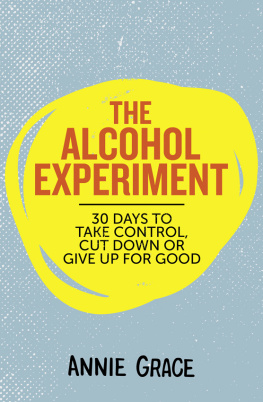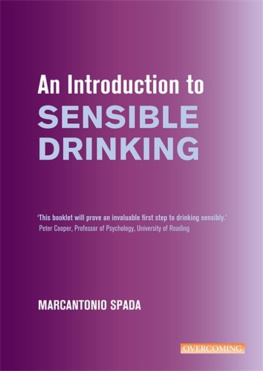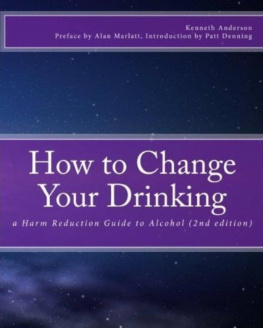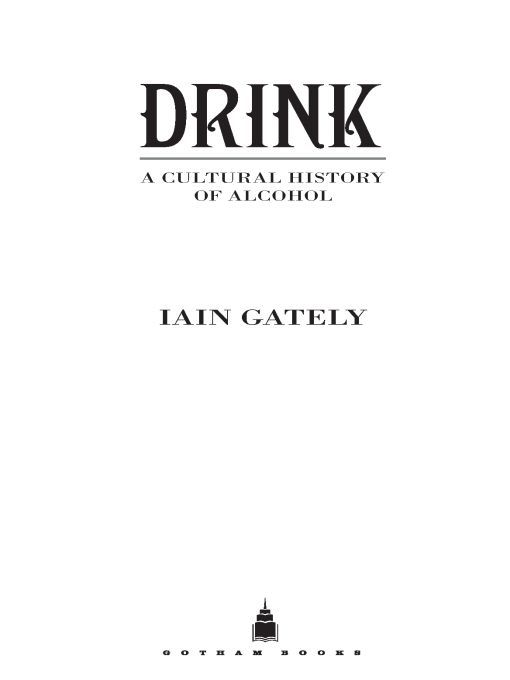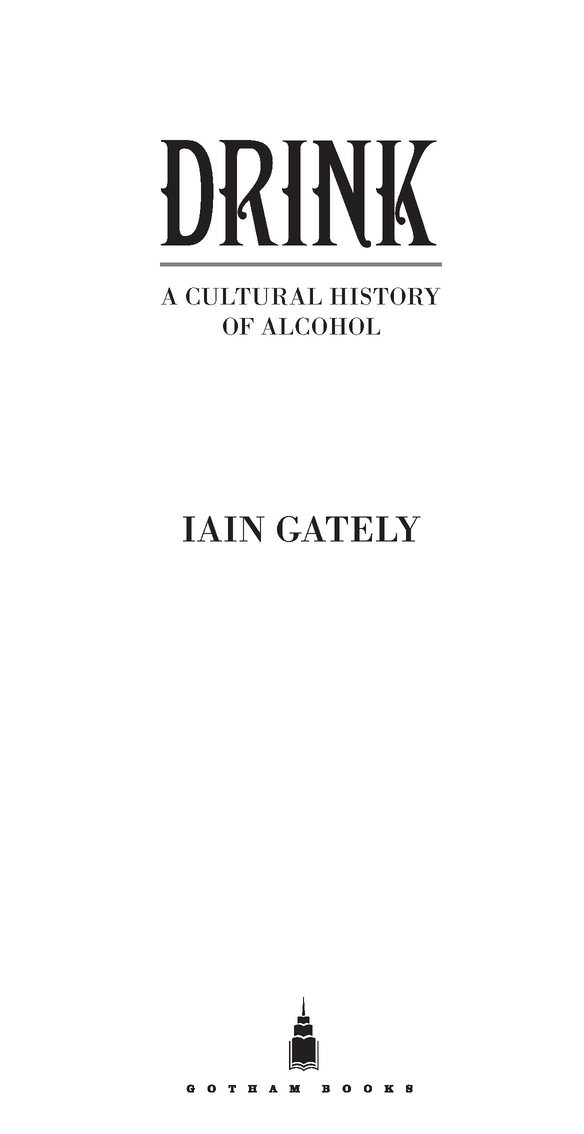Table of Contents
ACKNOWLEDGMENTS
My most sincere thanks to Anne Hedley, who made California seem my home, and to Jeff Grossman for his aid and inspiration. The Alcohol Research Group in Berkeley were models of friendliness and efficiency; Andrea Mitchell, in particular, guided me toward works favoring the creed of Homer. The staff of the British Library maintain their reputation for excellence. Finally, my particular thanks to Jim Rutman at Stirling Lord Literistic and Simon Trewin in London for their advice and assistance at every stage.
INTRODUCTION
The first time I ever saw my grandmother drink alcohol was when she accepted a small glass of champagne on her hundredth birthday. She pronounced it to be pleasant but not so good as to want more. My uncle teased his mother over waiting so long to take a drink and she replied with a concise sermon on its dangers to the young: It made them vain and indolentand what was the value in that? She had been steadfast in her indifference to drink, and in her outright opposition to drunkenness since her childhood. Born in 1906, in Kilmarnock, in Scotland, the home of Johnnie Walker whisky, she emigrated to America in the 1920s. Her new country was dry at the time: National Prohibition had commenced a few years before, and it was illegal to sell alcohol as a recreational beverage. In the event, she found herself one of the few willingly sober people in the immigrant community. Upon arrival in Brooklyn she shared an apartment whose other occupants, as was the custom, had annexed the bathtub for making home brew. Late one evening the doorbell rang, one of her flatmates opened the door, and Gran caught sight of a uniform. She rushed to the bathroom, locked herself inside, and drained away the hoochto the fury of her companions, and the policeman, who had dropped by for a drink.
They made such a fuss, she said.
They have my sympathies.
My own experience of alcohol has been very different from that of my grandmother. I am certain that I had drunk more of it before my twenty-first birthday than she had throughout her entire century. To her it was a useless substance, which changed peoples characters for the worse, whereas to me it has been a source of pleasure, which has made celebrations brighter, friendships deeper, and which has served on occasions as a temporary relief from sorrow. Such contrasting views may be found among people of both our generations, indeed, throughout history.
1 THE GRAIN AND THE GRAPE
Alcohol is a fundamental part of Western culture. It is the most controversial part of our diet, simultaneously nourishing and intoxicating the human frame. Its equivocal influence over civilization can be equated to the polar characters of Dr. Jekyll and Mr. Hyde. At times its philanthropic side has appeared to be in the ascendant, at others the psychopath has been at large. Throughout history, the place of alcohol in our meals, medicines, and leisure activities has been a matter of fierce debate. Whereas some cultures have distinguished it as a sacred fluid, whose consumption should be limited to ceremonial occasions, others have treated it as a kind of food and ignored, or accommodated, any incidental effects that it might have upon the psyche, and a few have even tried to exclude it from society altogether. Such differing views have often been concurrent, thus increasing the mystery surrounding alcohol. In both ancient Greece, and the present millennium, it has been credited with the powers of inspiration and destruction.
The substance at the center of this controversy, the chemical soul of all alcoholic drinks, is ethanol, which in its pure state is a colorless and highly volatile liquid. It is classified as a depressant, in the sense that it inhibits the functions of the central nervous system. It is also biphasic, meaning that its effects on the drinker vary in accordance with the quantity consumed. In small doses, ethanol generates a sense of euphoria and diminishes inhibitions. Larger quantities cause slowed brain activity, impaired motor function, slurred speech, and drowsiness; and in very high doses it is fatal. Moreover, when the body metabolizes ethanol, it is broken down into acetaldehyde, a far more toxic substance, which generates headaches, nausea and lethargy, and a heightened sensitivity to loud noises and sudden movements, which can persist for days after drinking.
Alcohol occurs naturally as a by-product of fermentationthe action of sugar-eating yeasts on fruits. It is a highly nourishing substance one ounce of pure ethanol contains 224 calories75 percent more than refined sugar. It is also sweet in flavor when diluted, making it attractive to most living creatures. Insects, birds, and even elephants have been observed to seek it out in the wild and to exhibit signs of drunkenness after consuming it. It is certain that humanity, and indeed our predecessor species, were exposed to alcohol and its side effects in the process of feeding themselves.
So how did we fall in love with this equivocal fluid? When did we begin to prepare it for ourselves? For most of the 160,000 years of our existence as a species, we lived in small bands of hunter-gatherers. The only mementos these distant ancestors have left are their own bones, a few tools chipped out of stone, and evidence that they had fire and perhaps a belief in an afterlife, for they buried their dead with care. It is impossible to know what part alcohol played in their lives, but to judge by the habits of existing tribes of hunter-gatherers, it is likely that they had a taste for it and that they assembled to enjoy natures bounty in places where fruits were ripening. In Mexico, for example, tribes in marginal regions who did not grow their own food nonetheless would travel great distances in order to be present when certain cacti came into fruit so that they could make alcohol. Those tribes who lacked the technology of pottery used hollowed-out logs as fermentation vessels. One tribe that lacked both pottery and access to tree trunks had discovered a method of weaving watertight baskets to contain the cherished fluids.
Definite evidence of the preparation of alcoholic drinks first appears around 8000 BC after humanity took up agriculture and established sedentary communities. The earliest proof that they were converting some of their produce into brews derives from the chemical analysis of the residues found inside pottery jars discovered in a grave in Jiahu, in northern China, and dating to 7000-6600 BC. These clay vessels, coincidentally the most ancient of their kind, contained a fermented drink made with rice, honey, grapes, and hawthorn berries. Further evidence of prehistoric brews comes from Transcaucasia, part of present-day Georgia, where grape pips have been discovered around Neolithic settlements with shapes that differ slightly from those of wild grapes, suggesting that they had been cultivated. Moreover, pottery fragments from the same area, decorated with what appear to be human figures raising their arms in celebration, and dating circa 6000 BC, confirm that its inhabitants had the technology, and the desire, to store liquids, and thought fit to adorn their containers with joyful images.
Proof that people were cultivating plants to manufacture alcohol first appears in the so-called Fertile Crescent, a geographical area curving between the Mediterranean and the Persian Gulf. The analysis of a yellow residue found on the inside of a jar at a Neolithic settlement in Haji Firuz Tepe (Iran), dating to 5400-5000 BC, revealed that the jar had once held wine. The residence in which it was discovered had six such jars, and other houses in the same hillside village also had similar vessels, in comparable quantities. The amount of wine each household might have produced suggests that it was a small but significant part of their diet. In such communities, winemaking was the best technology they had for storing highly perishable grapes, although whether the resulting fluid was intended for intoxication as well as nourishment is unknown. It is likely that the inhabitants of the Fertile Crescent were also making mead from honey and beer from their surplus grain in the same era. The first proof that beer was being brewed in the region derives from the residues of an alcoholic barley brew found in a pottery vessel at Godin Tepe, in the Zagros Mountains of Iran, and dating to 3100-2900 BC. As is the case with the wine of Haji Firuz Tepe, whether this ur-beer was made to stimulate or simply as a kind of food remains a mystery.



